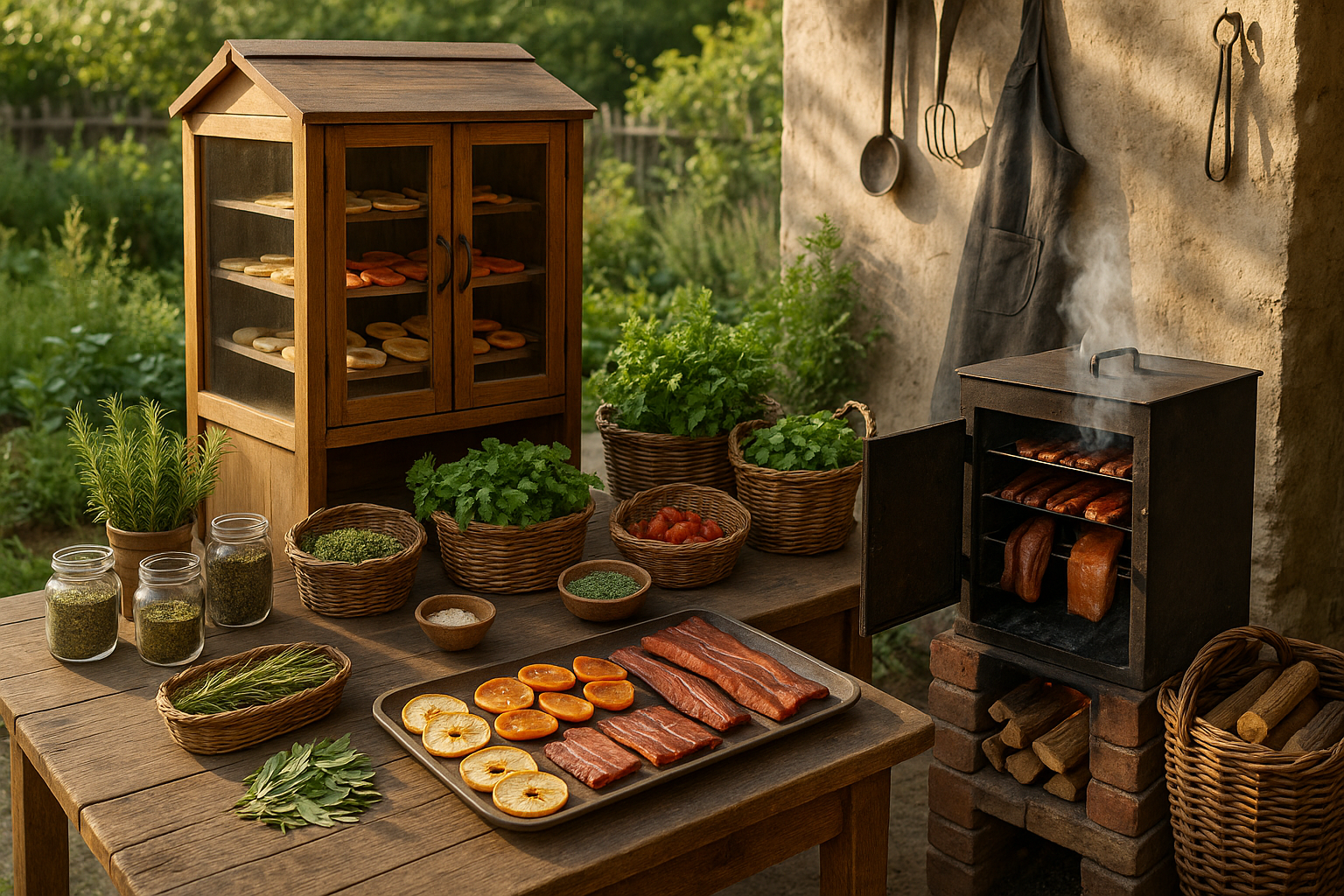In an age where the quest for wellness and a harmonious living environment is more pertinent than ever, we find ourselves yearning for spaces that not only reflect our personalities but also nurture our well-being. Imagine stepping through your front door and being greeted by a delightful aroma, a visual feast of greens, and the promise of tranquility and health. This is not a fantasy reserved for lush estates or the pages of a luxury home magazine; it is an accessible reality that starts right at your doorstep. Welcome to the transformative world of vibrant herb gardens, where your entrance becomes a canvas for creativity and a sanctuary for the senses. 🌿
Herb gardens have been celebrated for centuries, cherished by everyone from medieval monks to modern chefs, for their culinary, medicinal, and aesthetic contributions. Yet, their potential to revitalize and refresh our homes is often overlooked. By strategically incorporating a herb garden into your entranceway, you not only enhance the visual appeal of your home but also create a dynamic environment that promotes health and wellness. Herbs such as lavender, rosemary, and mint offer a symphony of scents that can soothe the mind and invigorate the spirit, making every arrival a mini retreat from the chaos of the outside world.
In this comprehensive exploration, we will delve into the multifaceted benefits of transforming your doorways with herb gardens. We’ll start by exploring the aesthetic transformation they bring, discussing how various plant arrangements can add a touch of elegance and vibrancy to any entrance. From classic pots to vertical installations, there are endless design possibilities that cater to any style or space. We’ll provide you with tips on choosing the right herbs for your environment, considering factors such as climate, sunlight, and maintenance preferences, ensuring that your garden not only survives but thrives. 🌱
Beyond aesthetics, herb gardens are a treasure trove of wellness benefits. We will uncover the medicinal properties of various herbs, shedding light on how a simple touch or sniff can uplift your mood, boost your immune system, and even improve your cognitive functions. Imagine coming home after a long day, plucking a few basil leaves to unwind with a fresh cup of tea or infusing your meals with home-grown flavors that bring both taste and vitality. These gardens offer more than beauty; they are a sustainable, health-boosting addition to your home that pays dividends long after the initial planting.
Lastly, we will explore the broader implications of welcoming wellness into your home through herb gardens. This is not just about cultivating plants; it’s about cultivating a lifestyle that prioritizes well-being and sustainability. We’ll discuss how this small step contributes to a more eco-friendly existence and fosters a deeper connection with nature. Whether you live in a sprawling house or a compact apartment, the potential to harness the power of plants to create a welcoming and fragrant entrance is within reach. Join us as we embark on this journey of transformation, inviting nature to our thresholds and embracing the vibrant life it brings. 🏡
Understanding the Basics of Herb Gardens
Creating an herb garden at your doorway can be a delightful way to infuse freshness and fragrance into your home environment. Not only do herbs provide a beautiful aesthetic, but they also offer culinary and medicinal benefits that can enhance your everyday life. Before embarking on this journey, it’s important to understand the fundamentals of herb gardening to ensure success. Whether you’re a seasoned gardener or a beginner, the basics remain crucial for cultivating a thriving herb garden.
Herb gardens can vary widely in size and complexity. They can range from simple potted plants on your doorstep to elaborate arrangements that transform your entrance into a verdant oasis. The primary consideration is the selection of herbs. Popular choices include basil, mint, rosemary, thyme, and lavender. These herbs are known for their vibrant appearance and versatile uses. When selecting herbs, consider the climate of your area, the amount of sunlight your doorway receives, and your personal preferences.
Location is key to the success of your herb garden. Most herbs require a minimum of six hours of sunlight daily. If your doorway doesn’t receive enough natural light, you may need to consider alternative options such as using grow lights. The soil quality is another critical factor; herbs thrive in well-drained soil rich in organic matter. You might want to use a potting mix specifically designed for herbs or create your own by mixing equal parts of potting soil, perlite, and compost. Regular watering, while avoiding waterlogging, will help keep your herbs healthy.
Designing Your Herb Garden for Aesthetic Appeal
Designing an herb garden is not just about planting herbs; it’s about creating a welcoming space that complements the architecture and style of your home. Start by assessing the available space and consider how the garden will be integrated into your existing landscape. A harmonious design will not only enhance the curb appeal of your home but also create a more enjoyable and functional space.
Container gardens offer flexibility in design and placement. Choose pots and containers that match the aesthetic of your home. Terra cotta pots are popular for their classic look and breathability, while modern options like ceramic or metal containers can provide a sleek and contemporary appearance. Grouping different herbs together can create visual interest and allow you to experiment with color and texture.
Incorporate vertical elements to maximize space and add dimension to your garden. Vertical planters, hanging baskets, and trellises can be used to grow climbing herbs such as climbing rosemary or thyme. These structures not only save space but also create a lush backdrop for your entrance. Check out the video below for creative vertical gardening ideas:
Watch Vertical Gardening Ideas – Garden Answer
The Benefits of Herb Gardens at Your Entrance
Herb gardens offer numerous benefits beyond their visual appeal. One of the most significant advantages is the accessibility to fresh herbs. Having a herb garden right at your doorstep means you can easily harvest herbs for cooking, teas, or home remedies, providing a fresh and flavorful addition to your meals. This accessibility not only enhances your culinary experience but also promotes a healthier lifestyle by encouraging the use of fresh ingredients.
In addition to culinary benefits, many herbs are known for their medicinal properties. For instance, lavender is renowned for its calming effects and can be used in teas or aromatherapy. Mint is often used to soothe digestive issues, while rosemary can enhance memory and concentration. By growing these herbs at home, you have a ready supply of natural remedies at your fingertips.
Another significant benefit of herb gardens is their ability to improve air quality. Herbs like basil and mint release aromatic compounds that can purify the air and provide a pleasant fragrance. This can create a more inviting and refreshing atmosphere for both residents and visitors. Moreover, gardening itself is a therapeutic activity that can reduce stress and enhance mental well-being. Planting and caring for an herb garden can be a rewarding experience that fosters a sense of accomplishment and connection to nature.
Comparative Table: Popular Herbs and Their Uses
| Herb | Culinary Uses | Medicinal Benefits |
|---|---|---|
| Basil | Pesto, salads, soups | Anti-inflammatory, aids digestion |
| Mint | Teas, desserts, sauces | Digestive health, stress relief |
| Rosemary | Roasts, breads, marinades | Memory enhancement, antioxidant |
| Thyme | Soups, stews, marinades | Antiseptic, respiratory health |
| Lavender | Desserts, teas, syrups | Calming, stress relief |
Explore the table above to discover the various culinary and medicinal uses of popular herbs. This knowledge can help you choose the best herbs for your garden based on your personal needs and preferences.
Maintaining and Caring for Your Herb Garden
Once your herb garden is established, maintenance becomes key to ensuring its longevity and productivity. Regular care not only helps your herbs thrive but also prevents potential issues such as pests and diseases. The effort you put into maintaining your garden will be rewarded with lush growth and a bountiful harvest.
Watering is one of the most critical aspects of herb garden maintenance. Herbs generally prefer soil that is moist but not waterlogged. Overwatering can lead to root rot and other issues, so it’s important to monitor the moisture level of your soil. Most herbs require watering every few days, depending on the climate and weather conditions. In hotter months, you may need to water more frequently, while in cooler, wetter seasons, you may need to reduce watering.
Pruning is another essential task that promotes healthy growth and prevents your herbs from becoming leggy. Regularly trimming your herbs encourages bushier growth and helps prevent them from flowering prematurely, which can reduce their flavor. Prune herbs like basil and mint by pinching off the tips, and use sharp scissors or pruning shears for tougher stems like rosemary and thyme.
Common Issues in Herb Gardens and Solutions
- Pest Control: Aphids and spider mites are common pests that can affect herbs. Introduce beneficial insects like ladybugs or use insecticidal soap to control infestations.
- Diseases: Fungal diseases such as powdery mildew can occur in humid conditions. Improve air circulation by spacing plants appropriately and avoid overhead watering.
- Nutrient Deficiency: Yellowing leaves can indicate a lack of nutrients. Use organic fertilizers to feed your herbs and ensure they have the necessary nutrients to thrive.
By being proactive and addressing these common issues, you can maintain a healthy and productive herb garden. Remember that each herb has its own specific care requirements, so research and tailor your approach to meet the needs of your specific plants.

Conclusion
Creating a vibrant herb garden at your doorstep not only enhances the aesthetic appeal of your home but also invites a myriad of benefits that go beyond the visual delight. As we’ve explored throughout this article, these verdant sanctuaries can transform any entrance into a welcoming gateway of fresh aromas and serene beauty. Let’s take a moment to revisit the key points discussed and understand why cultivating an herb garden can be a transformative experience, both for your living space and well-being.
First and foremost, herb gardens are an exceptional way to infuse natural beauty and fragrance into your home environment. By strategically selecting a variety of herbs, such as basil, rosemary, lavender, and mint, you create a sensory-rich experience that delights visitors and inhabitants alike. The aromas emanating from these plants not only provide a warm welcome but also have therapeutic properties that can enhance mood and reduce stress. This fusion of visual appeal and olfactory delight is a testament to the power of nature in enhancing our daily lives.
Moreover, cultivating a doorway herb garden is a step towards sustainability and self-sufficiency. In an age where organic and locally sourced produce is highly valued, having immediate access to fresh herbs is a practical and eco-friendly choice. The convenience of stepping outside and picking fresh basil for your pasta or mint for your tea not only enriches your culinary endeavors but also reduces the carbon footprint associated with transporting store-bought herbs. This practice aligns with sustainable living principles, encouraging a lifestyle that respects and harmonizes with nature.
In addition to the practical benefits, engaging in the cultivation of a herb garden has profound impacts on mental health and wellness. Gardening is a therapeutic activity that fosters mindfulness and relaxation. As you nurture your plants, you cultivate patience and responsibility, qualities that have far-reaching effects on your overall well-being. The act of tending to your garden serves as a daily ritual, grounding you in the present moment and providing a sense of accomplishment as you witness your efforts blossom into lush greenery.
Furthermore, an herb garden at your entrance serves as an inspiring conversation starter and a bridge to community engagement. Whether you live in a bustling city apartment or a suburban neighborhood, sharing your passion for gardening can connect you with like-minded individuals and build a sense of community. Swapping gardening tips or sharing herb cuttings can foster friendships and create a network of support and shared knowledge, enriching your social interactions and enhancing communal ties.
The aesthetic value of a well-curated herb garden cannot be understated. By choosing colorful and diverse plants, you create a visual masterpiece that enhances your home’s curb appeal. This not only increases the property value but also instills a sense of pride and joy in your living space. The presence of greenery and vibrant hues creates a welcoming and inviting atmosphere that reflects the personality and warmth of the inhabitants.
As we conclude our exploration of the transformative power of herb gardens, it is important to acknowledge the broader implications of such practices. Embracing nature at our doorsteps is a reminder of our connection to the earth and the responsibility we bear to protect and nurture our environment. By cultivating a herb garden, you are taking an active role in promoting biodiversity and contributing to the ecological balance.
In conclusion, the simple act of transforming your doorways with vibrant herb gardens is a powerful expression of creativity, sustainability, and wellness. It is an invitation to embrace nature’s gifts and integrate them into our daily lives, enriching our surroundings and elevating our spirits. We encourage you to take the inspiration from this article and embark on your gardening journey. Whether you’re a seasoned gardener or a novice, there is always room to grow and explore.
Share your experiences, thoughts, and ideas with us and your community. Let’s cultivate a culture of wellness and green living, one herb garden at a time. Feel free to comment below with your own gardening tips or share pictures of your vibrant entrances. Together, we can inspire others to create beautiful, fragrant sanctuaries that welcome wellness into our homes and hearts. 🌿✨
For further reading and resources, consider exploring the following links that offer a wealth of information on herb gardening and sustainable practices:
3. Royal Horticultural Society
These resources provide practical tips and insights into the world of gardening, ensuring that your journey is as rewarding and fulfilling as possible. Happy gardening!




